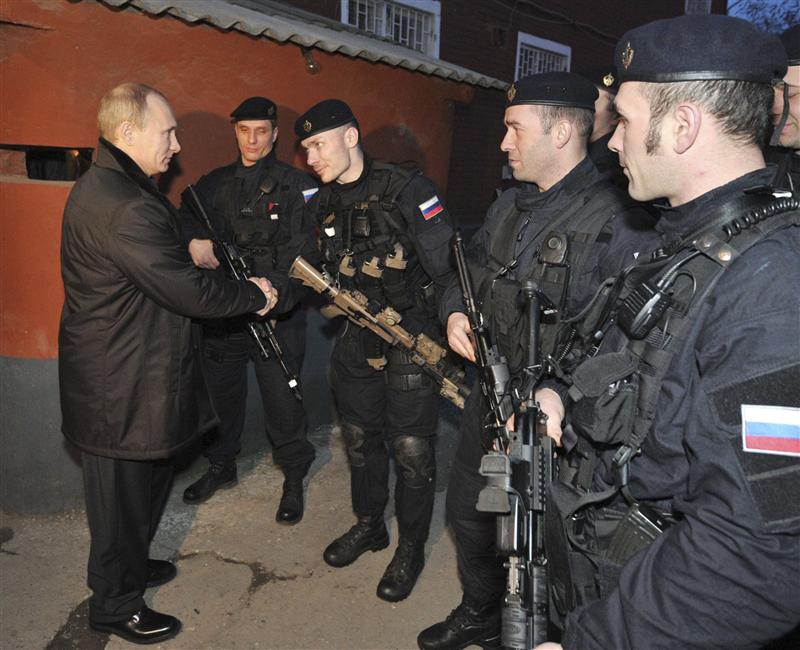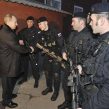
Putin Signals He Will Stick to the Status Quo in Chechnya
Publication: Eurasia Daily Monitor Volume: 9 Issue: 4
By:

The end of 2011 saw another visit by Vladimir Putin to Chechnya. Putin’s first visit to Chechnya took place on December 31, 1999, while he was still serving as prime minister under President Boris Yeltsin. (Putin visited neighboring Dagestan several months earlier — in August 1999.) Putin visited Chechnya next on March 20, 2000, when he flew to the republic in an Su-27 military strike aircraft as a second pilot. On a visit to Chechnya on April 14, 2001, Putin laid a wreath at a spot in Chechnya’s mountainous Shatoi district where a whole company of Russian special forces had been destroyed by several dozen Chechen militants the previous year. In 2004, Putin visited Chechnya twice – first on May 11, immediately after Akhmad-haji Kadyrov was assassinated in a rebel attack, and then on August 22, when he traveled to the republic to ease the tensions between Kadyrov’s followers and those of Moscow’s then-protégé, Alu Alkhanov. On December 12, 2005, Putin went to Chechnya to take part in a session of the republic’s newly elected parliament. On October 16, 2008, Putin traveled to Chechnya to inspect damage caused by a strong earthquake. On that trip Putin also visited a boulevard in Grozny named after him by Ramzan Kadyrov. On August 24, 2009, Putin briefly visited Chechnya to personally support Kadyrov.
Thus Putin’s latest visit to Chechnya on December 20, 2011 – one anxiously awaited by Ramzan Kadyrov, was his ninth trip to the republic. Kadyrov received Putin at his suburban residence in Gudermes, 30 kilometers east of Grozny. According to Grozny residents, the security measures taken for Putin’s visit were unprecedented. Policemen in uniform and plain clothes were deployed in every house along the highway on which Putin apparently traveled from Grozny to Gudermes. Snipers were on the roofs of all high-rise buildings. All traffic was banned in a radius of several kilometers around Putin’s travel route, and local residents were advised to stay indoors while the Russian prime minister was in Chechnya (www.kavkaz-uzel.ru, December 21, 2011). Although the visit itself was short, it was an ordeal for the people of Grozny and Gudermes, paralyzing both population centers for a whole day in order to ensure the safety of the high-profile guest from Moscow. Gudermes was apparently selected as Putin’s destination instead of reconstructed Grozny also for security reasons: Kadyrov’s suburban residence is a real fortress, protected on one side by the Terek River and positioned outside the town.
During his visit, Putin characteristically sharply criticized those who are calling for the North Caucasus region to be cut off from Russia because it is financially burdensome. Putin called their arguments “wild.” It was interesting to note that he justified the need to allocate funds to the North Caucasus by the fear that otherwise the region’s population would migrate to other regions of Russia, which would create new problems. According to Putin, local youth would also join the militants, and Russians in other regions would be sent to fight a fratricidal war fight in the North Caucasians (www.profi-forex.org/news/entry1008098544.html). For the first time, Putin reverted to such primitive discussions about the need to inject funds into the North Caucasus. Such an argument would have been expected from Vladimir Zhirinovsky, but not from the former and future president of the Russian Federation.
Putin also did not fail to mention that if the North Caucasus republics were to secede from Russia, other regions of the country would follow their lead. However, Putin’s arguments against the North Caucasus region’s secession looked a lot like concealed propaganda for its secession. Otherwise, it is hard to explain how the once and future president of Russia had no better arguments for keeping the region in the Russian Federation. The weakness of Putin’s arguments will become the counterargument of those who favor the secession of the North Caucasus republics – primarily Chechnya, Ingushetia and Dagestan – from Russia.
While visiting Chechnya, Putin also touched upon the issue of high unemployment in the region, especially in Chechnya and Ingushetia (www.rf-region.ru/news/133.htm). The government is ready to provide guarantees for investment projects. However, given the complete ruin of Chechen industry – the republic is currently operating at only 6-7 percent of its prewar level of industrial output – it is pointless to promise a breakthrough in the next ten years (www.profi-forex.org/news/entry1008099014.html). All of the republican government’s hopes for privatization of the oil industry are delusionary, given that Chechnya is in 21st place in the Russian Federation in terms of the amount of oil extraction and in 16th place in terms of natural gas extraction, and that the republic’s oil wells are on the verge of exhaustion. Today, Chechnya produces very few of its own goods; all food products in the republic’s markets are brought in from outside.
Putin also noted Grozny’s successful reconstruction, although he could not possibly have seen the reconstructed central part of the republic’s capital: given that his travel route was to the east of it and the speed at which he was driven around, he hardly could have received any reliable impressions about the city.
Four days before his visit to Grozny and Gudermes, Putin mentioned Ramzan Kadyrov during his annual call-in TV program on December 16. Putin said he knew “there are many claims against the head of Chechnya, Ramzan Kadyrov, but he is reconstructing [the] republic and the ‘corruption ingredient’ is minimal” (www.rg.ru/560639-anons.html). Putin’s statement should be regarded as direct support for his henchman in Chechnya, and as a sign that he intends to continue supporting Kadyrov after again becoming Russia’s president.
Thus, Vladimir Putin’s ninth visit to Chechnya was an expression of personal support for Ramzan Kadyrov and Putin’s other henchmen in the republics of the North Caucasus. These are the same leaders who are regularly accused by their respective populations of corruption and human rights breaches. These leaders frequently do not really understand what is going on in their regions, which makes their policies absurd and provokes radicalism. Having concluded that the secession of the North Caucasus republics would lead to the disintegration of the Russian Federation, Putin thereby acknowledged that the situation in the region is exactly the same as it was 20 years ago – i.e., at the moment of the USSR’s dissolution in December 1991. During that period, Russia did not move forward even a single step; on the contrary, having launched a war across the North Caucasus, it has taken several steps backwards.




